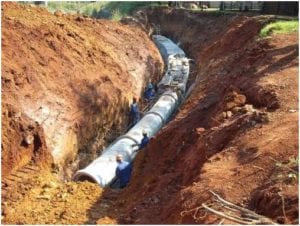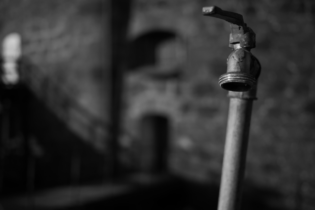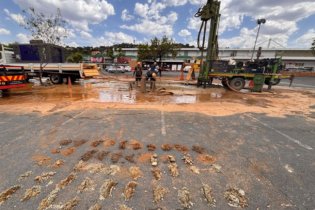Rapid urbanisation in the City of Tshwane put the sewer system in the eastern suburbs under considerable pressure.
The City commissioned a major multi-phase project to upgrade the existing Moreleta Spruit Outfall Sewer System to meet current demands and future expansion requirements. Walter Aust, Associate: Water Engineering at Aurecon and Johan Wessels, City of Tshwane, Deputy Director: Replacement and Upgrading tell Chantelle Mattheus that innovative engineering solutions and genuine concern for the needs of residents and the environment are overcoming challenging site conditions and laying a successful foundation for future growth in the area. As a result of significant population growth and expansion of business areas in the City of Tshwane over recent years, existing infrastructure – including the outfall sewer networks in various parts of the city – is progressively subject to increased pressure. One of the areas that isparticularly impacted is the Moreleta Spruit sewer drainage area. The parallel line solution To provide for the expansion and densification of urban development in the east of Pretoria, the Water and Sanitation division of the City of Tshwane identified the need to upgrade the existing outfall sewer system to provide more capacity for current demands and future expansion requirements. It was decided to construct a parallel outfall sewer line to augment the existing line, rather than replace it with a new line catering for the total required capacity. This in essence will double the capacity of the Moreleta Spruit Outfall Sewer as there will be a duplicate outfall sewer system. “The new pipeline is mainly located on the opposite side of the river from the existing outfall sewer, says Wessels. This will enable the existing river crossings to be connected to the new pipeline. Where possible and practical, the existing river crossings will be retained to allow cross-connection between the existing and new pipeline to assist with refurbishment work that might be undertaken at a later stage. The construction was originally scheduled in four phases: Phases 1A and 1B as well as 2A have been completed. The scope of Phase 2A and B entailed the construction of 9.2 km of a concrete outfall sewer pipeline with diameters ranging between 600 and 1 350 mm. The works include eleven pipe jacks, totalling almost 1 000 m in length, in congested site conditions – an immense undertaking for even the most experienced of teams. Project breakdown Aurecon has been involved with this project, providing a comprehensive range of services, since its first implementation in 2004. For Phase 2B, Aurecon was appointed as lead consultant to execute certain stages of the project, namely the feasibility study, planning and preliminary design, environmental impact assessment, geotechnical investigation, detail design, tender documentation and adjudication. Aurecon is also responsible for site supervision together with occupational health and safety monitoring and regulation. Phase 2B is currently under construction, with Aust and Wessels estimating 83% of the work to have been completed,even though only 70% of the scheduled timeline has elapsed. The contractor appointed is VF Munisi Civils and the contract duration is set for 30 months, with construction having commenced in September 2011. The final construction value of Phase 2B is projected at R45 million and is earmarked for completion in February 2014. During the planning phase, information was sourced from existing master planning studies. Aurecon also consulted with City of Tshwane Metropolitan Municipality City Planners and Plan Associates to ensure that the latest available development planning was incorporated into the calculation of the projected future sewage flows from the Moreleta catchment area. It was confirmed that the 2025 planning figures used, would be representative of the ultimate development condition. The pipeline follows a route that passes through a variety of land use areas, varying from open veld and rock outcrops to urban and residential areas in close proximity to existing buildings and numerous forms of overhead and underground infrastructure.The geotechnical investigations also revealed that an extensive volume of hard rock would be encountered and that groundwater seepage could be expected along most of the route. Consequently, the contractors had to be informed that the works required difficult and challenging mitigation measures in terms of the following:- accommodation of spoil material
- management of groundwater and seepage into trenches
- shoring of trenches
- removal and reinstatement of fences and barricades on the pipeline route
- special conditions of work near Transnet Pipeline services
- potential flooding of works adjacent to the Moreleta Spruit, particularly during rainy seasons.
“Due to the meandering of the Spruit, the new outfall frequently had to be installed in a very narrow footprint. To circumvent the problem in one especially difficult area, the project manager and the Aurecon management team decided to deviate a section of the existing outfall to make way for the installation of the new outfall,” explains Aust. “This involved the excavation of the pipe trench by means of Krings boxes, a specialist shoring system imported from France.”
The task was to excavate to a depth of 5 m, in a 10-m footprint between an 800 mm bulk water main and the 825 mm existing outfall sewer, and beneath overhead power lines. The specially imported Krings boxes allowed the execution of the works in a safe and risk-free manner. Some of the other interesting technologies and processes implemented on-site include the use of deflected socket pipes to construct long radius curves along the route, as well as the supply ofcalcium aluminate cement (CAC) sacrificial layer concrete pipes by Southern Pipeline Contractors. A caring approach The environmental management and rehabilitation of impacted areas form an important part of the project. The environmental approval for the project was obtained, with the Record of Decision issued on 20 February 2007 and the Water Use Licence granted on 24 February 2010. The detailed Environmental Management Plan conforms to both authorisations and is applied and monitored strictly to mitigate the environmental impact of the works. Open spaces in the eastern suburbs of Pretoria have become a scarce commodity, one of the aims of the project is, as far as possible, to leave an even ‘cleaner and greener’ landscape behind once construction and rehabilitation have been completed. As a result, the Phase 2B pipeline route was locally rerouted to avoid existing trees. More suitable indigenous trees are planted to replace thosethat had to be removed during construction. The Phase 2B contractor has allocated additional resources to the Faerie Glen Nature Reserve to increase the progress in the reserve. Rehabilitation works, including grassing, hydroseeding and planting of trees are a priority and will commence as soon as all the construction activities in the area have been completed.The rehabilitation will be environmentally closely monitored, with activity, including the control of alien vegetation, continuingfor a one-year maintenance period following completion of construction work. Rehabilitation on pipeline projects can normally only be assessed properly over a period of two to three rainy seasons. On virtually the total length of Phase 1 of the project, the pipeline route can, after two to three years, no longer be differentiated from the surrounding veld. Some environmental and conservation aspects that are achieving very positive results include the careful monitoring of footprint width and tree preservation. Addressing residents’ concerns At the request of a concerned resident, some temporary ropes were strung in the trees for the benefit of a local bush baby colony. The concern was that the necessary removal of a portion of a line of trees crossing the trench would destroy some of the habitat of the colony, even if only temporarily. “Although the trees will be replaced, the ropes provide a solution to the problem.,” Says Wessels. A phased approach to commissioning With Phase 1 completed, it is now possible to commission the new outfall sewer between the Derdepoort flow dividing structure (FDS) and FDS1, situated at Watermeyer Street. In addition, the Phase 2 upgrading has been divided into an extra phase to accommodate budgetary constraints. Phase 2A is complete and was recently commissioned while the construction of Phase 2B commenced in October 2011. The new Phase 3 will commence after Phase 2B has been completed. The objectives of Phase 3 are to upgrade, renew, rehabilitate and refurbish the existing collector sewers, which have structural defects and/or damage and to renew pipe sections already identified by the consultant, using traditional methods or new trenchless techniques. “This will provide a system with greater capacity to meet current needs as well as future expansion requirements, given the significant growth in urban development in the east and south oftheMoreleta drainage area,” Says Wessels. Lessons learnt A valuable lesson learnt by the team, was the enhanced cooperation from keeping the residents,impacted by the project, properly informed. Public participation in the form of newsletters proved very successful and a good community liaison officer formed an integral part of the communication line. In closing, Aust, Wessels and the project team would like to thank the public for their continued support, patience and understanding during the construction and augmentation of the new Moreleta Outfall Sewer. Despite all the challenges,such as seasonal flooding, the phases have been constructed and completed on time, within the approved contract values, and yearly budget. A notable achievement on a very demanding project.







